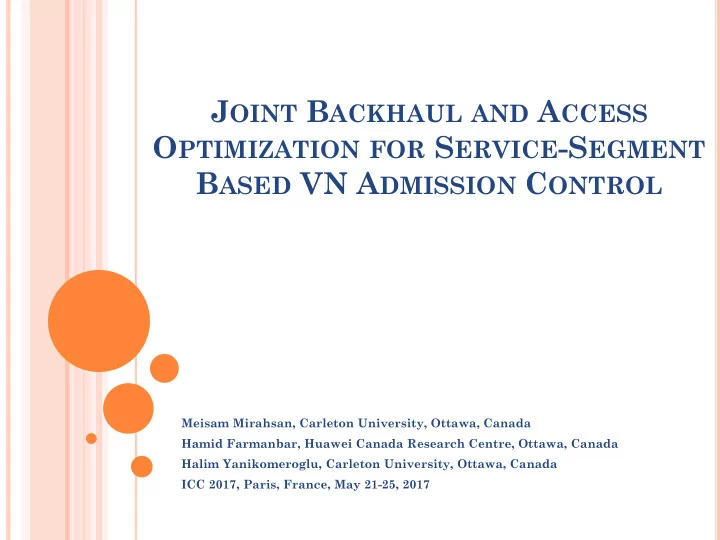

J OINT B ACKHAUL AND A CCESS O PTIMIZATION FOR S ERVICE -S EGMENT B ASED VN A DMISSION C ONTROL Meisam Mirahsan, Carleton University, Ottawa, Canada Hamid Farmanbar, Huawei Canada Research Centre, Ottawa, Canada Halim Yanikomeroglu, Carleton University, Ottawa, Canada ICC 2017, Paris, France, May 21-25, 2017
V IRTUAL N ETWORK A DMISSION C ONTROL Single user admission control Short term Based on deterministic user locations VN admission control Long term Based on user distribution probabilities Other requirements include QoS Service function chains (SFC) Such as encryption, aggregation, caching, … 2 Joint Backhaul and Access Optimization for Service-Segment-Based VN Admission Control M. Mirahsan, H. Farmanbar, H. Yanikomeroglu
R ESOURCE LIMITATIONS Access link limitations: BS to UE wireless connection Backhaul limitation: Small cells deployed by customers Service function nodes (SFN): Limited processing powers 3 Joint Backhaul and Access Optimization for Service-Segment-Based VN Admission Control M. Mirahsan, H. Farmanbar, H. Yanikomeroglu
VN A DMISSION C ONTROL P ROCESS 4 Joint Backhaul and Access Optimization for Service-Segment-Based VN Admission Control M. Mirahsan, H. Farmanbar, H. Yanikomeroglu
C ONTRIBUTIONS OF THE PAPER A novel wireless VN admission control method is proposed which incorporates both the access limitations and backhaul limitations for general network topologies. This problem is formulated as a joint convex optimization problem which is computationally tractable. Service segments and SFC constraints are included in the problem both in the sense of service function orders and the resource requirements at each service function node. A service-segment-based approach is put forth which is more scalable than its flow-segment-based counterpart. 5 Joint Backhaul and Access Optimization for Service-Segment-Based VN Admission Control M. Mirahsan, H. Farmanbar, H. Yanikomeroglu
P REVIOUS W ORKS Meisam Mirahsan, Gamini Senarath, Hamid Farmanbar, Ngoc Dao, and Halim Yanikomeroglu, “Admission control of wireless virtual networks in HetHetNets”, under review in IEEE Transactions on Vehicular Technology (submission: 22 Oct. 2016, 1 st results: 26 March 2017,1 st revision: 20 May 2017). Meisam Mirahsan, Halim Yanikomeroglu, Gamini Senarath, and Ngoc-Dung Dao, “Analytic modeling of SIR in cellular networks with heterogeneous traffic”, IEEE Communications Letters , vol. 20, no. 8, pp. 1627-1630, August 2016. Meisam Mirahsan, Rainer Schoenen, H. Yanikomeroglu, G. Senarath, Ngoc-Dung Dao, “User-in-the-loop for HetHetNets with backhaul capacity constraints”, IEEE Wireless Communications, Special Issue on Smart Backhauling and Fronthauling for 5G Networks , vol. 22, no. 5, pp. 50-57, Oct. 2015. Meisam Mirahsan, Rainer Schoenen, and Halim Yanikomeroglu, “HetHetNets: Heterogeneous traffic distribution in heterogeneous wireless cellular networks”, IEEE Journal on Selected Areas in Communications, Special Issue on 6 Recent Advances in Heterogeneous Cellular Networks , vol. 33, no. 10, pp. 2252- 2265, October 2015. Joint Backhaul and Access Optimization for Service-Segment-Based VN Admission Control M. Mirahsan, H. Farmanbar, H. Yanikomeroglu
S YSTEM MODEL We consider the downlink of a cellular wireless network with general access and backhaul topologies. A geographical region Q ⊂ R 2 (i.e., two dimensional plane) which is divided into small bins is assumed as the network layout that is served by a set of BSs B. Each BS is characterized by its available bandwidth W k . We assume that demand arrivals for the i th VN service, v i ∈ V, at location q in bin j, d ij , are random variables that follow arbitrary distributions with mean λ ij , where V is the set of VN services. The backhaul network is modeled as a directional graph G(N,L), where N and L are the sets of nodes and links in the network, respectively. Let L in (n) and L out (n) be the sets of links terminating and originating at 7 node n ∈ N, respectively. Joint Backhaul and Access Optimization for Service-Segment-Based VN Admission Control M. Mirahsan, H. Farmanbar, H. Yanikomeroglu
N ETWORK CONFIGURATION 8 Joint Backhaul and Access Optimization for Service-Segment-Based VN Admission Control M. Mirahsan, H. Farmanbar, H. Yanikomeroglu
F LOW SEGMENTATION In order to address the flow traversal constraints, each flow is parsed according to its traversal constraints into multiple flow segments. 9 Joint Backhaul and Access Optimization for Service-Segment-Based VN Admission Control M. Mirahsan, H. Farmanbar, H. Yanikomeroglu
F LOW - BASED VN ADMISSION CONTROL 10 Joint Backhaul and Access Optimization for Service-Segment-Based VN Admission Control M. Mirahsan, H. Farmanbar, H. Yanikomeroglu
S ERVICE - BASED VN ADMISSION CONTROL The flow-based approach does not scale with increasing number of flows or flow segments in terms of admission control algorithm complexity. We parse flows according to their SFC requirements into flow segments. A service segment is defined as a set of flow segments with common source node. 11 Joint Backhaul and Access Optimization for Service-Segment-Based VN Admission Control M. Mirahsan, H. Farmanbar, H. Yanikomeroglu
S ERVICE - BASED VN ADMISSION CONTROL 12 Joint Backhaul and Access Optimization for Service-Segment-Based VN Admission Control M. Mirahsan, H. Farmanbar, H. Yanikomeroglu
S ERVICE - BASED VS F LOW - BASED 13 Joint Backhaul and Access Optimization for Service-Segment-Based VN Admission Control M. Mirahsan, H. Farmanbar, H. Yanikomeroglu
S IMULATION SETUP 14 Joint Backhaul and Access Optimization for Service-Segment-Based VN Admission Control M. Mirahsan, H. Farmanbar, H. Yanikomeroglu
S IMULATION RESULTS 15 Joint Backhaul and Access Optimization for Service-Segment-Based VN Admission Control M. Mirahsan, H. Farmanbar, H. Yanikomeroglu
THANKS! S! Q UESTI ESTIONS ? 16
Recommend
More recommend